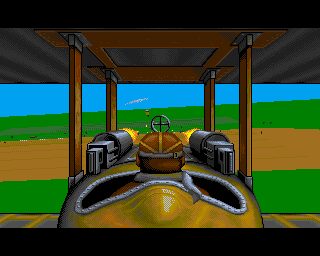F-15 Strike Eagle II, developed and published by MicroProse in 1989, is a combat flight simulator for PC. The game, released also for Amiga and Atari ST in 1991, places players in the cockpit of one of the most iconic fighter jets of the Cold War era. As a sequel to the original F-15 Strike Eagle designed by Sid Meier, this installment built upon the foundation of its predecessor with improved graphics, more missions, and a deeper sense of realism—though still leaning more toward the accessible side of flight simulation rather than full-on military authenticity.
The game offers players the chance to fly the F-15 in a variety of Cold War-era scenarios set across multiple geopolitical hotspots, including Libya, the Persian Gulf, Vietnam, and Central Europe. Each theater presents its own tactical challenges, terrain features, and enemy threats. The primary mission types include air-to-air engagements, ground attack runs, and bombing operations, and the player must manage both fuel and limited munitions while navigating enemy radar and missile threats.
What made F-15 Strike Eagle II particularly engaging for its time was its balance of action and simulation. Unlike the more demanding simulators of the era, it didn’t require complex procedures to get off the ground. Players could jump in quickly and experience dogfights with Soviet MiGs or conduct low-level bombing runs on enemy SAM sites. That said, it still retained enough depth to appeal to fans of the genre, with different radar modes, weapon types (AIM-9 Sidewinders, Mavericks, bombs), and realistic flight physics for the time.
Graphically, the game was a significant improvement over the original. The first chapter was developed for 8-bit computers, while Strike Eagle 2 is for 16-bit computers. So it offers a cleaner and more detailed 3D engine, smoother animations, and enhanced cockpit instrumentation. While primitive by modern standards, its vector-based visuals were immersive enough to convey a convincing sense of flight and speed. The sound design was functional, with missile alerts, engine hums, and explosions providing essential audio cues during missions.
The game also featured a scoring and medal system that rewarded successful missions, kills, and objectives completed. Pilots could earn promotions and decorations, adding an RPG-like progression element that encouraged replayability. A debriefing screen after each mission provided a summary of performance, further enhancing the immersive military experience.
Critics at the time praised F-15 Strike Eagle II for its accessibility and strong action-sim blend, with many pointing out that it was a perfect entry point for players new to the genre. It may not have been as technically complex as titles like Falcon or Flight Simulator 4, but it delivered satisfying gameplay and a solid challenge.
Ultimately, F-15 Strike Eagle II became one of MicroProse’s best-known titles during the late 1980s and early 1990s. It was followed by F-15 Strike Eagle III in 1992, which pushed the realism and technical fidelity even further. For many players, though, the second installment struck the right balance between realism and fun, and remains fondly remembered as one of the defining military flight sims of its generation.













